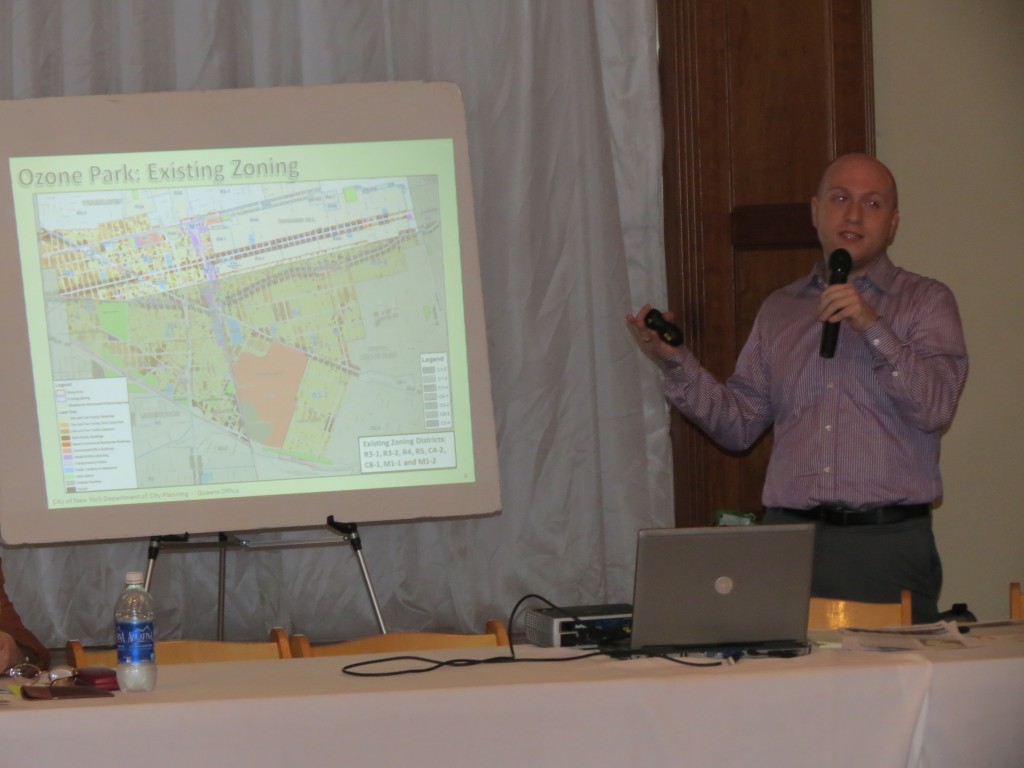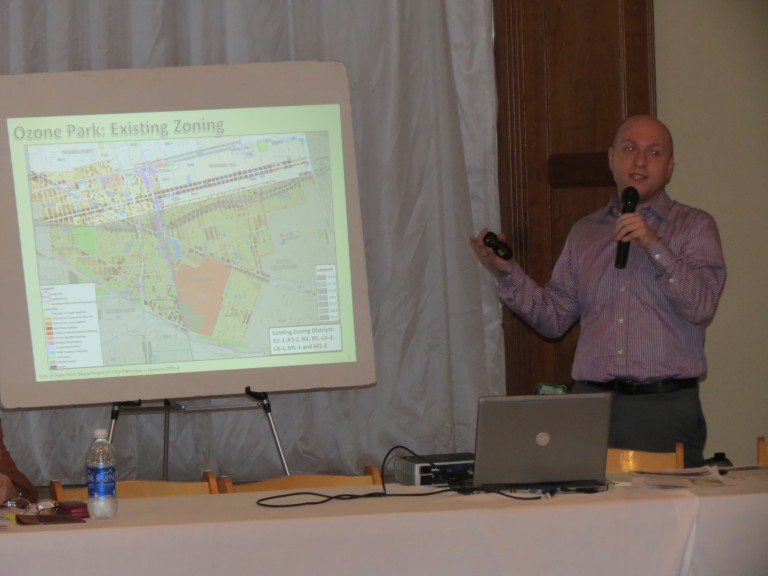
City Planner Tom Smith discusses the 530-block rezoning proposal for Ozone Park and surrounding areas at Community Board 9 this week. Anna Gustafson/The Forum Newsgroup
A massive 530-block rezoning plan for Ozone Park landed the support of Community Boards 9 and 10 over the past week, which elected officials and civic leaders say will lead to preserving the neighborhood’s character and create wanted business growth in commercial areas.
“If you are born and raised in Ozone Park, you know this is our time,” Councilman Eric Ulrich (R-Ozone Park) said. “Five, 10 years from now you’ll see good, responsible development happening.”
The city’s proposal – the first of its kind since 1961 which stemmed from concerns from both community boards, elected officials and civic organizations – now must receive officials stamps of approval from the borough president and the City Council before being implemented. With both community boards backing the rezoning – CB 10 backed it unanimously at its meeting last Thursday and CB 9 greenlighted the plan on Tuesday evening – that additional approval is almost guaranteed.
All but one member of CB 9 voted to approve the rezoning, which is the second largest rezoning for the Bloomberg administration and, in addition to Ozone Park, also includes parts of Woodhaven, South Ozone Park and South Richmond Hil. The proposal would rezone the area generally bounded by Rockaway Boulevard, Atlantic Avenue and 101st Avenue to the north; the Van Wyck Expressway and Lefferts Boulevard to the east; the Belt Parkway to the south; and the Brooklyn borough line to the west.
“This rezoning protects the neighborhood character and reinforces existing development patterns,” said Tom Smith, of the city Department of Planning. “It strengthens the character of the neighborhood’s commercial corridors and supports mixed-use development. It also prevents commercial encroachment onto residential blocks by reducing the depth of commercial overlays and matching land use patterns with commercial overlays.”
The rezoning would create nine new zoning categories. A number of the areas would be zoned to ensure houses remain on the small side, with 50 blocks becoming R3A, mainly in Ozone Park’s Centreville area, South Ozone Park and South Richmond Hill. Such a district is characteristic of a number of the city’s older neighborhoods that feature single- and two-family detached residences.
Only one- and two-family detached homes on lots that must be at least 35 feet wide would be permitted in the R3X zone, which would impact about 54 blocks, much of which is in South Ozone Park and South Richmond Hill.
About 130 blocks, mostly in Ozone Park, would become R4A, which would allow for one- and two-family detached houses that would be located on slightly smaller lots than those in R3X districts.
The city would designate about 215 blocks – the largest residential zone in the proposal – as R4-1, which permits one- and two-family detached or semi-detached units. Thirty-one blocks would be zoned R4B, and about 11 blocks would be designated as R5B – both of which would allow for what are typically low-rise rowhouse districts.
To funnel business into desired areas, city planners said 215 blocks would be designated as R6B, which would allow for apartments to sit atop storefronts along 101st and Liberty avenues. About eight blocks along Cross Bay and Rockaway boulevards would be zoned R5D, which would allow for mixed-use buildings that are no taller than 40 feet. This, planning officials said, would allow stores to exist on the ground floor and have space for offices or community areas on other floors.
Many civic leaders, as well as elected officials, said they are looking forward to seeing what kind of development the rezoning will bring. Ozone Park Civic Association President Howie Kamph has, for example, said it should keep smaller houses on tree-lined streets while paving the way for larger-scale commercial developments that people want to see – like a T.G.I. Friday’s or Applebee’s for example. Additionally, Kamph and Ulrich said the rezoning would deter larger box stores – such as a Target or Home Depot – from opening.
By Anna Gustafson

